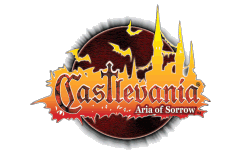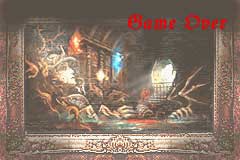|
|

|
BATTLE SYSTEM
|

|
INTERACTION
|

|
ORIGINALITY
|

|
STORY
|

|
MUSIC & SOUND
|

|
VISUALS
|

|
CHALLENGE
|
Stiff
|
COMPLETION TIME
|
15-30 hours
|
|
OVERALL
4.5/5
|
Rating definitions
|
|
|
Castlevania Action-RPGs were a known quantity in 2003, and Konami’s development team seemed to have mostly recycled their previous processes on Castlevania: Harmony of Dissonance. Recognizing this, the next installment found Konami trying to innovate a bit while retaining the familiar Castlevania elements. The innovations are by and large successful, while the game itself seems to have been granted more polish than its predecessor. Castlevania: Aria of Sorrow is not perfection, but it does represent quite possibly the finest iteration of Castlevania to be found on the Game Boy Advance.
A fascinating storyline had never been delivered by a Castlevania title prior to Aria of Sorrow, and the development team wanted to change that. They failed. This is not necessarily for lack of trying, more a recognition that storyline is not a fundamental part of the Castlevania framework. At the very least, things are rather different in this title than in any previous one: it is set in 2035, 36 years after a Belmont by the first name of Julius seemingly destroyed Dracula once and for all. Soma Cruz finds himself sucked inexplicably into the mysteriously reappeared castle of Dracula however…. At least this is not QUITE as obvious a plot as it could be. But story seekers are forewarned; nothing grand is to be found here.
 Vegas odds-makers will probably be happy to bet on how often this screen is seen.
Vegas odds-makers will probably be happy to bet on how often this screen is seen.
|
|
Visuals are at the same high level as those found in Harmony of Dissonance, only they look less… flamboyant this time around. Harmony of Dissonance seemed obsessed with distraction at all times, while Aria of Sorrow has more content to back up its graphics, making them less omnipresent. Soma does not walk with multiple silhouettes trailing him at all times as Juste Belmont did, which is markedly less distracting. Hopefully this makes sense…. Audio is a distinct improvement upon the immediate predecessor Castlevania title, although it does not quite compare with Symphony of the Night’s beautiful music. This time at least the music takes advantage of the difference in audio capabilities between the original Game Boy and the Game Boy Advance. Vocals are at the same level found in earlier Castlevania games on GBA, with grunts and guttural utterances but nothing specific.
Superficially Aria of Sorrow plays just like Symphony of the Night, Circle of the Moon and Harmony of Dissonance. Soma wanders about Dracula’s castle, progress proceeding in a very Metroid-influenced fashion. Enemies when slain cough up experience along with money and sometimes items. Beyond this framework, however, there is a very big change that influences the play quite distinctively.
Sub-weapons are gone from the castle. In their place one will find the Soul system, which is the major innovation found in Aria of Sorrow. Every time Soma kills an enemy, there is a slim chance that the enemy will cough up its soul (bosses give up their souls automatically unless the enemy reappears later on). Souls come in three different types: those that are activated by pressing up and B, akin to a sub-weapon’s use, those that are activated by holding down the R button, and those that are always active unless switched for something else. One soul of each type can be in place at a time. The souls that are not automatically in use require magic points to use, and many of them will drain Soma’s MP gauge very fast. Few souls are vital to progress, and those that are will be given to the player. Finding all of them can be quite addictive, however. And this will require searching the castle comprehensively, because certain enemies are never seen outside of a small area off the beaten path. Proper soul usage will negate the need to gain repeated levels, as the soul effects can be used to increase Soma’s abilities as needed.
 In a little-known occurrence of the Middle Ages, court jesters could be replaced by Mermen until the Mermen were made into the court dinner.
In a little-known occurrence of the Middle Ages, court jesters could be replaced by Mermen until the Mermen were made into the court dinner.
|
|
Other than the Soul system the game plays precisely as one would expect a Castlevania game to. Tight control is a must, and the game has it. One interesting item is Soma’s lack of a whip (as he is not a Belmont); he tends to have bladed weapons instead, although later on he can obtain a gun. Equipping items that are found and switching souls around is accomplished without travail; the map is as easily accessible as one would want: interaction is not an issue.
Completion time of the game will vary from player to player, as certain souls can make the job much easier. Also, the first ending one will probably come upon is not the last. Once the game is complete it can be begun again with all souls previously obtained kept, which makes rushing through it rather simple. Completion of the entire game (meaning the first ending is not enough) earns the player the ability to play through the game as Julius Belmont, in what is essentially a version of classic Castlevania. And there is the temptation to track down all souls available, which will suck up massive time….
The challenge found here is not quite blistering, but is sufficient to send RPGamers without good action-gaming skills away. These skills are vital to completion of Aria of Sorrow, and even with the right souls in place enemies (particularly bosses) will not stand still. Action-RPG veterans will not find anything nail-bitingly tough but will also have no need to ingest caffeine to remain awake.
The Game Boy Advance never lacked for quality RPG-oriented titles, and Aria of Sorrow proves why. It had a grand legacy in the Castlevania universe to live up to, and succeeds. That it does not quite equal Symphony of the Night is no shame when it comes so very close. And really, that it just might be the closest Konami has come to equaling Symphony of the Night is all needing to be said.
Review Archives
|









